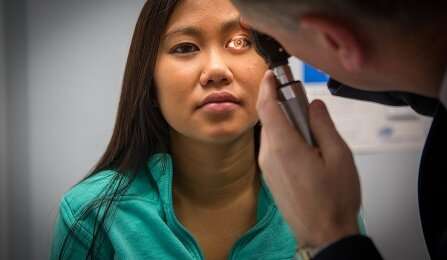Problems with vision are among those that UB researchers have identified as an indication that a child or adolescent with a concussion will have delayed recovery. Credit: Douglas Levere
Researchers at the University at Buffalo's Concussion Management Clinic have developed a brief, standardized physical exam for sport-related concussive brain injuries in children and adolescents that can readily identify who is at risk for persistent post-concussion symptoms (PPCS).
The Buffalo Concussion Physical Examination's Risk of Delayed Recovery (RDR) score is the first decision rule to help clinicians who aren't concussion specialists quickly identify which children are at risk for PPCS within 10 days of injury and should be referred to a specialist for focused treatment. A decision rule is an evidence-based tool that helps clinicians make diagnostic and therapeutic decisions.
The research was described in a paper published Sept. 11 in the British Journal of Sports Medicine.
The decision rule proved to be highly accurate, correctly identifying who would go on to develop PPCS in 85% of cases.
"The Buffalo Concussion Physical Exam takes less than 10 minutes to do and uses physician exam techniques that every clinician already has," said M. Nadir Haider, MD, Ph.D., first author and assistant director of research in the Concussion Management Clinic in the Jacobs School of Medicine and Biomedical Sciences at UB and UBMD Orthopedics and Sports Medicine.
To promote the adoption of the Buffalo Concussion Physical Exam, Haider plans next to develop an app that can generate the RDR score identifying children who will experience delayed recovery based on the findings from the exam.
Current standard delays treatment
Children and adolescents tend to take longer to recover from concussion than adults. Still, for the majority of those who experience a concussion, symptoms will resolve within a month or less without any treatment. For that reason, it is standard practice to wait a few weeks to see if symptoms resolve on their own before patients are referred for treatment. But as many as a third of concussed patients will experience PPCS and require focused treatment.
"The current standard of practice is to wait and see for the first four weeks," said Haider. "But our research and other studies have shown that in children and adolescents, delayed treatment can lead to a higher risk of persistent impairments with poor outcomes."
Students with PPCS continue to suffer, experience physical and cognitive symptoms, and start exhibiting difficulties with academic work and even in their social lives, Haider said. "So preventing these outcomes is pretty important."
Buffalo decision rule circumvents the waiting period
"Right now, there is no gold standard method to identify children within a few days of injury who will have delayed recovery from their concussion. So the current standard of practice is to see which children do not recover, and this leads to unnecessary delays," said Haider. "This scoring system may circumvent the waiting period for those children at higher risk, expediting the treatment they need for a full recovery."
The new decision rule is based on an observational study conducted from 2016–19 on 270 children and adolescents with sport-related concussions who were seen within 14 days of injury at UBMD Orthopedics and Sports Medicine clinics in Western New York. (Physicians in UBMD Physicians' Group are faculty members at the Jacobs School.) Participants were aged 8–18 and 38% were female. They were followed until they had recovered from their concussion and were cleared to return to school or sports without restrictions.
"The purpose was to identify what is predictive of delayed recovery in children and adolescents with concussion," said Haider. "We wanted to develop something very straightforward that any provider, from a school nurse to a medical resident to a primary care provider, could easily do," said Haider.
The UB researchers found that the primary signs that indicate that a child or adolescent with a concussion will have delayed recovery were:
- Lightheadedness and dizziness on standing up from a supine position.
- Problems with balance and vision that indicate issues with the vestibular ocular reflex, the reflex that allows us to maintain stability in vision while moving.
- Difficulty performing a tandem gait test, where participants are instructed to walk heel-to-toe.
More information: Mohammad Nadir Haider et al, Derivation of the Buffalo Concussion Physical Examination risk of delayed recovery (RDR) score to identify children at risk for persistent postconcussive symptoms, British Journal of Sports Medicine (2021). DOI: 10.1136/bjsports-2020-103690
Journal information: British Journal of Sports Medicine
Provided by University at Buffalo






















